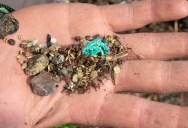Microplastics Found In Sediment Layers Untouched By Humans

If you’re paying attention, you probably know by now that microplastics are literally everywhere – our food, rainwater, babies in the womb, you name it.
While we’re not exactly sure of what the consequences are or will be, experts are fairly sure we’re not going to like them.
Now, microplastics have been found in a place human hands have never touched.
They’re showing up in sediment layers date back to the early 1700s, which means microplastics exist in places untouched by modern, plastic-making humans.

Scientists discovered this near three lakes in Latvia. They were planning to prove that the presence of microplastics could be a reliable indicator for the beginning of the Anthropocene Epoch.
Basically, they believed that the 1950s was the beginning of the large impact humans would have on the environment, so microplastics in the soil shouldn’t date beyond that.
Previously, researchers have relied on ash or ice to study past events on Earth.
These scientists are saying microplastics definitely aren’t as reliable, since they’re showing up far earlier in the sediment than humans could have physically put them there.
“We conclude that interpretation of microplastics distribution in the studied sediment profiles is ambiguous and does not strictly indicate the beginning of the Anthropocene Epoch.”

After all, microplastics have shown up even in Antarctica, where humans rarely spend time polluting the immediate area.
The real trick seems to be how to get rid of microplastics in our environment.
So far, the only thing we know for sure is that it won’t be easy.
If you think that’s impressive, check out this story about a “goldmine” of lithium that was found in the U.S. that could completely change the EV battery game.

Sign up to get our BEST stories of the week straight to your inbox.




